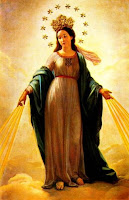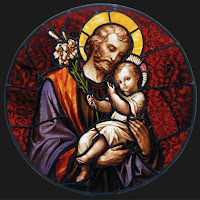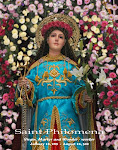3RD SUNDAY OF
EASTER B
YEAR OF CLERGY AND
CONSECRATED PERSONS
APRIL 15, 2018
Jesus, I trust in you!
 When the Lord appeared to his
disciples on the evening of Easter Sunday, they were terrified and thought that
they were seeing a ghost. However, the Lord quickly assured them: “Look at my
hands and my feet, that it is I myself. Touch me and see, because a ghost does
not have flesh and blood as you can see I have.” In order to prove that he was
no ghost, he ate fish in front of them.
When the Lord appeared to his
disciples on the evening of Easter Sunday, they were terrified and thought that
they were seeing a ghost. However, the Lord quickly assured them: “Look at my
hands and my feet, that it is I myself. Touch me and see, because a ghost does
not have flesh and blood as you can see I have.” In order to prove that he was
no ghost, he ate fish in front of them.
Perhaps you may ask: Why this
obsession that Jesus was resurrected in the flesh? It is because the
resurrection of the body is the novelty of the Christian Gospel. As we all
know, the continued existence of the human soul even beyond the death of the
body is something acknowledged by everybody. The body, which is subject to the
corruption of the material world, dies. However, the soul continues to live on.
This is why the apparition of the Risen Christ was mistaken for a ghostly
apparition. A ghost is a disembodied spirit. But the Risen Jesus is no ghost.
His body, which died on the Cross, has risen from the dead. The wounds on his
hands, feet and side proved to them that the body which was crucified and died
is the very same body standing before them. “The Author of life you put to
death but God raised him from the dead.”
And this resurrection of Jesus in
the flesh is important. The resurrection of the body of Jesus tells us that the
death of Jesus was real. It was not an illusion as heretics wanted to suppose. The
death of Jesus was real because the Incarnation was real. The 2nd
Person of the Blessed Trinity, God the Son, assumed a real human nature at the
Incarnation. This means that Jesus is not just a Divine Person who “appeared”
to have flesh and blood so that he can impart to us the secret knowledge we
need for spiritual enlightenment. This was what Gnosticism is all about. It is
a heresy that appeared some 120 years after the death and resurrection of the
Lord. It presupposes that the entire material universe is evil. Because it is
evil, it was impossible that God should take flesh for how could a holy God
cover himself with something that is evil? He simply appeared, which means Jesus
was not human. He appeared like a human being but he is not human. Therefore,
the crucifixion never happened. It was simply like a final act of a play that
was needed so that he could resume his proper angelic mode of existence, free
from any entanglement with our gross, material world. Gnostics believe that the
greed and lust all around us are simply due to our material bodies. Therefore,
salvation consists of the escape of the soul from the prison of the body so
that it can fly back to its heavenly home.
But Jesus said: “Touch me and see,
because a ghost does not have flesh and bones as you see I have.” Therefore, He
rose in his flesh. The flesh is not some gross, evil matter as if it were the
only one to blame for all the sins of the world. God created the material world
and he made it good. Man and woman were all created good. Sin was not caused by
the body. It was caused by the disobedience of the soul that dwelt in the body.
Sin was a decision of the soul which was acted out in the body. Therefore,
redemption was to be also a spiritual decision that also had to be acted out in
the body. The Son of God decided to obey the Father, and he was obedient unto
death, death on a cross. Therefore, the sacrifice of the body of Jesus on the Cross
was necessary to atone for sin and renew all creation. It was not enough for
the Savior to teach. He had to suffer and die. “Jesus is the expiation for our
sins…and for those of the whole world.” If Christ had to die in the flesh,
therefore, his resurrection was also in the flesh. God, who was pleased to
accept the sacrifice of his Son, raised Jesus from the dead. “God has brought
to fulfillment what he had announced through the prophets, that his Christ
would suffer.”
Therefore, the “gospel of Salvation
has a name and a human face: Jesus Christ, Son of God, Savior.” (Placuit Deo,
8.) “Christ is Savior inasmuch as He assumed the entirety of our humanity and
lived a fully human life in communion with his Father and with others.
Salvation, then, consists in our incorporation into his life, receiving his
Spirit (cf. 1 Jn 4:13). He became, ‘in a particular way, the origin of all
grace according to his humanity.’ He is at the same time Savior and Salvation.”
(PD, 11)
“In as much as we are saved ‘by
means of offering the body of Jesus Christ’ (Heb 10:10; cf. Col 1:22), true
salvation, contrary to being a liberation from the body, also includes its
sanctification (cf. Rom 12:1).” (PD, 14) And this sanctification of the entire
man, both body and soul, is brought about by our Lord’s Incarnation and Paschal
Mystery through the sacraments. The sacraments have visible signs because the
Lord sanctifies not only the soul but also the body. Jesus showed his disciples
his wounded hands and feet because they needed to see. In like manner, the Lord
left us the visible signs of the sacraments because of our need to see and
touch. Seeing and touching the sacraments, our bodies are sanctified as do our
souls. In order to reach out to our soul, he must address the senses. “Lord, I
am not worthy to have you under my roof, but only say the word and my soul
shall be healed.” He has to enter under the roof of our human flesh, his word
has to be heard by our ears, so that our soul may be healed.
O Mary conceived without sin, pray
for us who have recourse to thee!

















